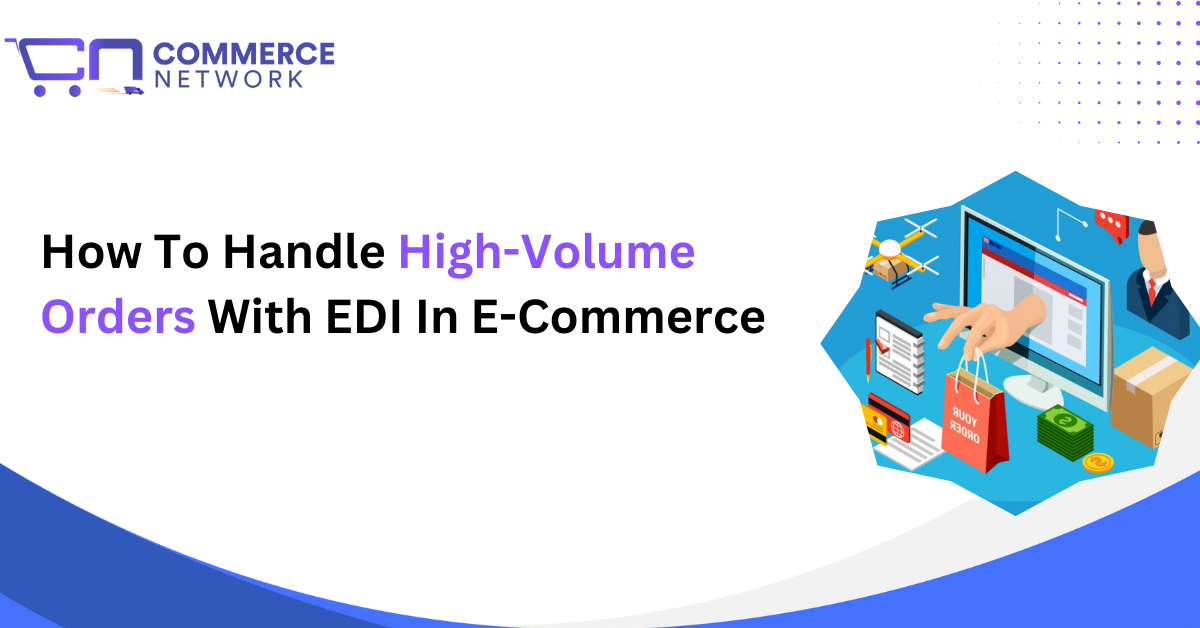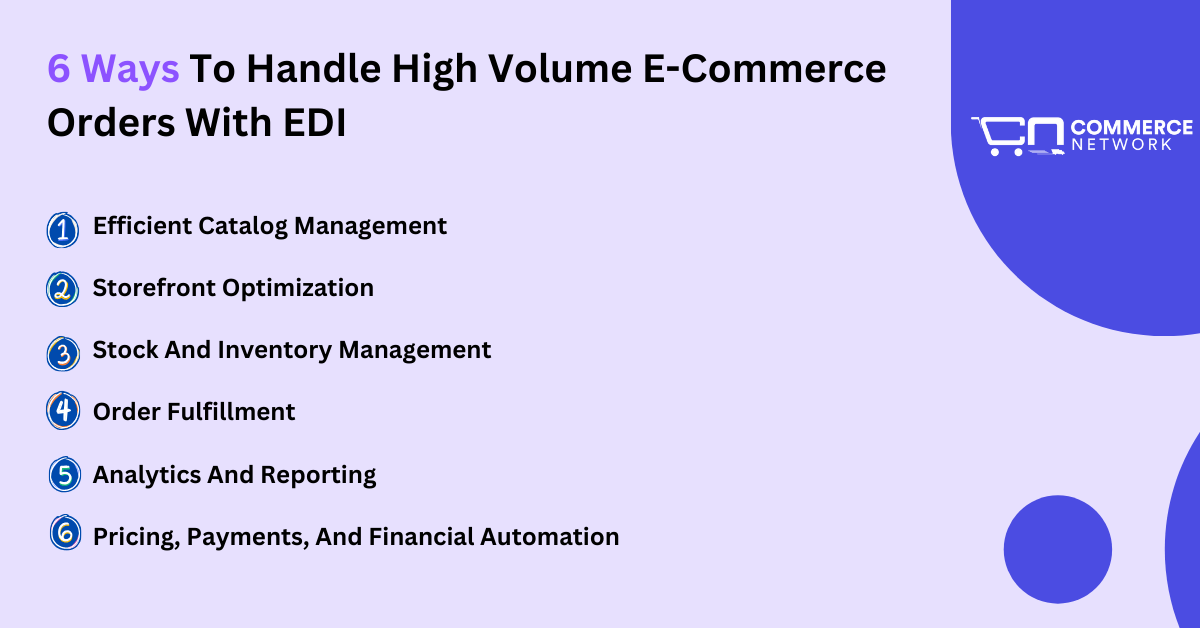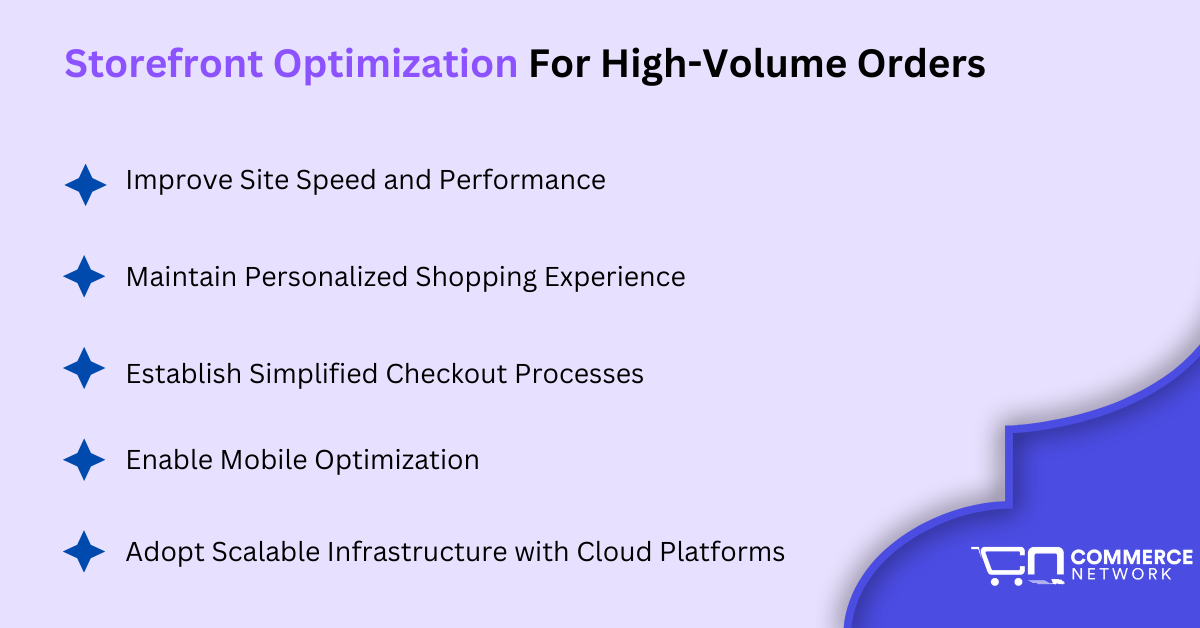By Bipin Dhungana | December 18, 2024

Handling high-volume orders is crucial if you want your e-commerce business to grow. Scaling up your B2B, B2G, and B2C transactions comes with a set of challenges that require a robust set of strategies.
As order volumes surge, challenges such as maintaining product availability, streamlining order fulfillment, and preventing bottlenecks become critical. To handle large amounts of orders effectively, you need accurate inventory management, order fulfillment, account processing, and more.
Electronic Data Interchange (EDI) streamlines the communication, integration, and management aspects of your e-commerce process by automating the exchange of documents, reducing manual errors, and saving time.
By integrating EDI into key processes such as catalog management, storefront optimization, and supply chain coordination, businesses can scale operations, meet customer demands, and maintain operational excellence during peak periods.
This article discusses 6 ways in which businesses can handle the high volume of their e-commerce orders and how EDI plays an integral role in that aspect.
The 6 efficient ways to handle high-volume e-commerce orders include catalog management, storefront optimization, inventory management, order fulfillment, payment processing, and analytics.
Let us discuss how they optimize e-commerce order handling and the role of EDI in each of them.

Managing your product catalogs in your storefronts, online marketplaces, and sales channels in real time to reflect any inventory changes or product classification is important.
If you are a business that sells a large variety of products, you need to manage your catalogs so that friction in both the customer shopping experience and backend operations are reduced and the processing of orders becomes smooth.
You should optimize your catalogs in real-time to reflect your inventory to avoid stockouts and excess and cause disruptions.
Here’s how efficient catalog management can help with high-volume orders:
Centralized catalog management ensures that product data (pricing, descriptions, stock levels, images, etc.) remains consistent and synchronized across multiple sales channels (online storefronts, marketplaces, third-party integrations, etc).
An efficiently managed catalog makes customers see accurate information and reduces cart abandonment due to incorrect or outdated product details.
EDI can integrate with your catalog and automate the exchange of product data between systems, ensuring consistency. Example: EDI documents like Product Catalog (EDI 832) can automatically update and maintain product information between suppliers, manufacturers, and online stores.
High-volume orders require handling a large number of SKUs (Stock Keeping Units). When a catalog is well organized, businesses can scale up the product listings by adding new product additions, seasonal changes, etc.
EDI automates product updates, allows product changes for existing products, and coordinates the availability statuses between suppliers, warehouses, and the e-commerce platform, thereby helping scale up product listings during peak periods.
It is essential to manage product variants if you are a business selling products with multiple variants (sizes, colors, styles, etc.).
Efficient catalog management allows customers to handle product variants for high-volume orders by allowing them to select and order preferred variants without any delays or issues.
EDI enables the transfer of variant information, such as specific colors, sizes, or model numbers, between vendors, suppliers, and the e-commerce platform. This keeps variant data organized and accurate.

Optimizing the e-commerce storefront helps maintain customer satisfaction and order processing.
The optimization of storefronts involves site speed, mobile optimization, simplified checkout processes, personalized shopping experiences, and more when dealing with high-volume orders.
Slow site speed is often the cause of abandoned carts, lost sales, and customer dissatisfaction during peak traffic times. Optimization of the storefront for speed ensures that customers can easily browse for products, process checkouts, and make high-volume orders smoothly.
To optimize storefronts, one can use Content Delivery Networks (CDNs), optimize for images and media to load faster, cache dynamic content like product details and shopping cart data, and reduce server load time.
While EDI itself doesn’t directly impact storefront speed, integrating EDI for storefront optimization ensures that once a purchase is made, backend systems are updated quickly, This helps in smooth order processing, and smooth customer experience.
High-volume orders often come from repeat customers or large businesses who expect a tailored shopping experience. Offering personalized recommendations, discounts, and custom offers based on customer behavior and preferences enhances the shopping experience and increases conversions.
So, businesses can use behavioral data to personalize product suggestions and content, provide dynamic pricing and promotions based on customer segments (e.g., wholesale, loyal customers), and implement custom product catalogs for different customer groups (e.g., government contracts, bulk buyers, etc.).
EDI can provide rich customer data and purchasing history through electronic transactions, enabling the e-commerce platform to personalize product recommendations, special offers, and pricing models.
For instance, EDI transaction data can be used to identify frequent buyers or bulk order customers and customize the storefront experience for them.
Long, complicated checkout processes can deter customers from completing their purchases, especially during high-volume sales periods. Streamlining the checkout process to minimize steps and data entry is key to improving conversion rates.
Businesses can offer guest checkout for customers who don’t want to create an account, integrate multiple payment options (credit cards, digital wallets, purchase orders), and use auto-fill features and address validation to reduce errors and speed up the process.
EDI can integrate directly with payment gateways to automate transaction processing. EDI messages such as Purchase Orders (EDI 850) and Invoice (EDI 810) can be exchanged to facilitate faster and more accurate order processing, reducing the likelihood of errors during checkout.
A large percentage of high-volume orders come from mobile users, so ensuring the storefront is mobile-friendly is critical. Responsive design, mobile-optimized checkout, and quick load times are essential for reducing cart abandonment on mobile devices.
E-commerce businesses can ensure the checkout process is streamlined for mobile devices (e.g., one-click checkout, autofill), implement mobile-friendly navigation, and use mobile-optimized payment options to streamline mobile storefront optimization.
EDI ensures that the stock and fulfillment data remain consistent, no matter the device used for the purchase. So, integrating EDI into mobile order processing ensures that orders placed on mobile devices are processed easily, and inventory is updated in real-time.
To reduce server crashes, slowdowns, and maintain a scalable infrastructure, one should leverage cloud-based platforms to make sure the storefront can handle traffic spikes without issues.
Using elastic load balancing for traffic distribution, implementing auto-scaling features, and maintaining backup servers help make robust infrastructure.
When integrated into a cloud-based e-commerce infrastructure, EDI ensures that order data, shipping updates, and inventory management are processed quickly from anywhere at any time, even during peak sales.
Start Your Storefront Optimization With Commerce Network
Managing stock and inventory is one of the most critical steps to ensure you can handle high-volume orders.
If the inventory is mismanaged, handling large-volume orders becomes impossible. Businesses cannot know about their stock of products, customers may need to wait for a long time. And high volume of orders across the e-commerce infrastructure may face disruptions, delivery errors, and other issues.
Here is how effective inventory management ensures that high-volume orders get fulfilled accurately.
To get an up-to-date and accurate view of the stock levels and prevent over or under-selling of products, it is necessary to ensure real-time tracking of inventory stocks.
Stock availability in real-time can make the high volume orders process smooth as both the suppliers and customers can easily get real-time data on how much of a product is available, what products are missing, what new products need to be added, and more.
Tracking the stocks also helps in customer satisfaction as they can get accurate data on their order status in real time.
EDI can be used to automatically update inventory levels with suppliers and customers. EDI-based Purchase Orders (POs) and Inventory Reports ensure that the system reflects accurate stock information in real-time, reducing manual entry errors.
EDI further facilitates automated stock reordering by exchanging electronic documents like Advance Ship Notices (ASNs) directly between systems, ensuring fast communication with suppliers.
Managing inventory across multiple warehouses or locations helps businesses fulfill orders more efficiently, especially when dealing with high volumes.
With EDI, businesses can send centralized inventory data to multiple locations, ensuring consistent inventory visibility across all warehouses. This also allows for efficient stock transfers between locations based on demand.
Predicting demand based on historical data helps ensure the right amount of stock is ordered during peak seasons.
EDI can be used to exchange historical order data, sales forecasts, and inventory reports with suppliers and partners. This helps improve demand planning, ensuring the right amount of inventory is available.

Order fulfillment is another extremely critical step in high-volume order processing for an e-commerce business. Order fulfillment includes receiving the order, shipping the order to the customer, and everything in between.
High-volume order fulfillment requires a streamlined and optimized workflow to handle customer demands. EDI streamlines and automates every stage: from order placement to shipping and invoicing. Here is how:
For high-volume businesses, automation is essential to process multiple orders simultaneously.
When a customer orders, EDI automatically captures the details, including product, quantity, and shipping address, generates a Purchase Order (PO), and transmits it to the supplier, warehouse, or fulfillment center.
This eliminates complications that may occur when handling multiple high-volume orders.
For large order volumes, real-time inventory updates are crucial to avoid overselling or stockouts.
EDI sends an Inventory Inquiry/Advice document to check stock levels to the inventory management system for processing.
High-volume orders require optimized workflows in the warehouse systems to ensure fast picking and packaging of products.
EDI can be integrated into the Warehouse Management Systems (WMS), ensuring the correct items are picked and packed efficiently. This helps manage large batches of orders without manual intervention.
Tracking details and shipment confirmations are essential for both the business and the customer during the transportation and delivery process.
EDI can be used to send and receive Advance Shipping Notice (ASN) to notify the customer as well as the e-commerce business about the shipment.
The ASN includes tracking numbers, expected delivery dates, and package details, improving visibility for high volumes of orders.
After shipping, businesses generate invoices to request payment. Error-free and timely invoicing ensures smooth cash flow for high-volume orders.
EDI automatically generates and sends invoices (EDI 810) to customers or partners eliminating manual billing, reducing errors, and speeding up payment cycles.
Functional acknowledgments confirm that documents like purchase orders and ASNs are successfully received. This validation step ensures no data is lost during high-volume transactions.
EDI sends a Functional Acknowledgment (EDI 997) to verify successful document exchanges. This maintains accuracy and transparency across all fulfillment stages.
However, as easy as it sounds to use EDI for your e-commerce order fulfillment, there are certain things you need to perform first.
Tracking performance helps identify inefficiencies and improve overall operations during high-demand periods while analyzing order data helps identify trends, potential issues, and operational bottlenecks.
EDI systems automatically transmit order data to analytics tools, enabling businesses to track key metrics in real-time. This helps make data-driven decisions to improve inventory management, fulfillment speed, and overall efficiency.
As a business owner, you can use dashboards to visualize metrics like order processing, shipping times, and inventory status. Dashboards can integrate with EDI systems to provide real-time updates on orders, shipments, and inventory levels, allowing for quick identification of areas that need improvement.
Managing pricing changes and applying promotions or discounts during peak sales periods can become overwhelming. Automation and related systems allow for dynamic pricing and discounting based on the customer, time of purchase, or other factors.
EDI can facilitate the transmission of price updates and promotions, ensuring that discounts are applied correctly across all systems and orders.
Ensuring that payments are processed swiftly and securely is critical when dealing with large order volumes. To solve this, businesses need to use payment processors capable of handling high transaction volumes with minimal delay.
Fraud prevention is also a key to ensuring financial safety and loss for businesses. So, e-commerce stores need to implement strong security protocols like firewalls, encryptions, and EDI with built-in fraud detection systems to prevent fraudulent transactions, particularly during peak sales periods.
Commerce Network is an integrated cloud-based SaaS provider providing e-commerce and EDI integration services that help clients streamline their businesses and improve supply chain management.
Here is why you should use Commerce Network to handle the high amount of your e-commerce orders:
1. Commerce Network provides an integrated platform for tracking orders, and inventory, automating notifications, and improving efficiency for order processing.
2. You can use Commerce Network to optimize your e-commerce storefront with full catalog management, pricing updates, and product update features.
3. For government contractors working with high-volume orders, Commerce Network ensures full compliance with all government regulations and enables a smooth integration with GSA, FedMall, DLA, and other federal agency marketplaces.
4. Commerce Network’s EDI solution is fully capable of sending and receiving EDI documents in many different formats to ensure diversification.
5. With partnerships from a wide range of suppliers, distributors, retailers, and wholesalers, the onboarding process is made smooth so that you can easily integrate your e-commerce platform with the system and make it handle large order volumes.
6. The support staff at Commerce Network are available at any time to ensure error resolution and solve any and all issues with EDI transactions.
7. With collaboration partners ranging from office supplies, and janitorial supplies, to military contractors, the diverse range of participation has made Commerce Network’s platform all-inclusive to handle all types of orders from diverse industries.
8. You can easily integrate with Walmart, Amazon, Shopify, and business ERP systems like NetSuite and Accounting systems like Quickbooks for faster processing and fulfillment of high-volume orders from online marketplaces as well as your own online storefront.
Use Our Cloud-based EDI system for your E-commerce platform now.
Handling high-volume orders tests an e-commerce business of its resilience, scalability, infrastructure, and order processing capability. TO effectively handle large volumes of orders in an e-commerce environment, it is essential to integrate EDI into major business systems. You can use EDI to handle inventory management, perform efficient data exchange and communication, use data for analytics, and perform faster financial transactions to improve customer satisfaction, avoid losses, and increase profits.
Improve Your B2B, B2G, and B2C Ecommerce?
Integrate EDI For Efficiency, Compliance, and Scalability?
Just Curious About EDI?
Give Us A Call
202-280-7060